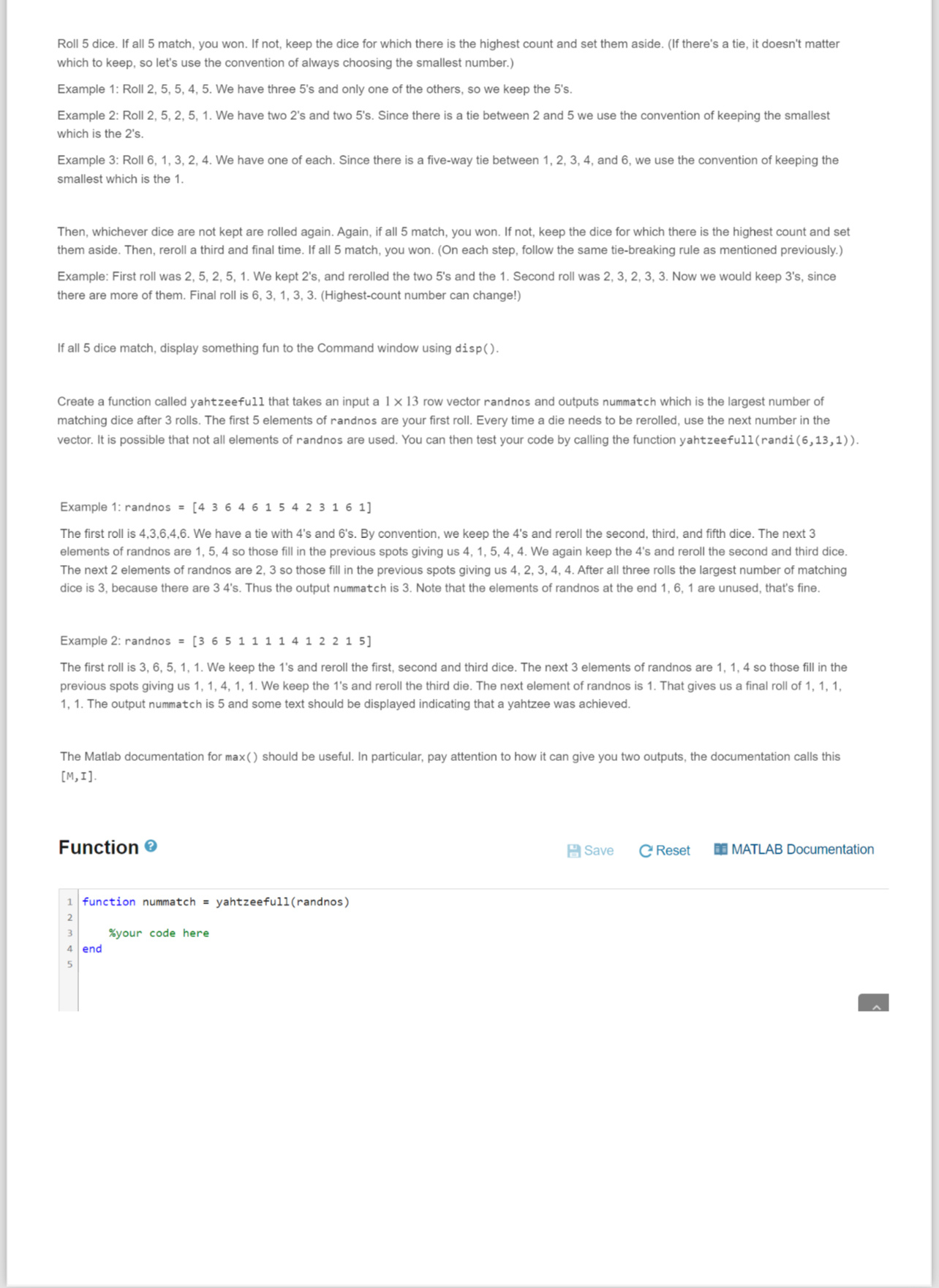Answered step by step
Verified Expert Solution
Question
1 Approved Answer
Roll 5 dice. If all 5 match, you won. If not, keep the dice for which there is the highest count and set them aside.
Roll dice. If all match, you won. If not, keep the dice for which there is the highest count and set them aside. If there's a tie, it doesn't matter which to keep, so let's use the convention of always choosing the smallest number.
Example : Roll We have three s and only one of the others, so we keep the s
Example : Roll We have two s and two s Since there is a tie between and we use the convention of keeping the smallest which is the s
Example : Roll We have one of each. Since there is a fiveway tie between and we use the convention of keeping the smallest which is the
Then, whichever dice are not kept are rolled again. Again, if all match, you won. If not, keep the dice for which there is the highest count and set them aside. Then, reroll a third and final time. If all match, you won. On each step, follow the same tiebreaking rule as mentioned previously.
Example: First roll was We kept s and rerolled the two s and the Second roll was Now we would keep s since there are more of them. Final roll is Highestcount number can change!
If all dice match, display something fun to the Command window using disp
Create a function called yahtzeefull that takes an input a row vector randnos and outputs nummatch which is the largest number of matching dice after rolls. The first elements of randnos are your first roll. Every time a die needs to be rerolled, use the next number in the vector. It is possible that not all elements of randnos are used. You can then test your code by calling the function yahtzeefull randi
Roll dice. If all match, you won. If not, keep the dice for which there is the highest count and set them aside. If there's a tie, it doesn't matter which to keep, so let's use the convention of always choosing the smallest number.
Example : Roll We have three s and only one of the others, so we keep the s
Example : Roll We have two s and two s Since there is a tie between and we use the convention of keeping the smallest which is the s
Example : Roll We have one of each. Since there is a fiveway tie between and we use the convention of keeping the smallest which is the
Then, whichever dice are not kept are rolled again. Again, if all match, you won. If not, keep the dice for which there is the highest count and set them aside. Then, reroll a third and final time. If all match, you won. On each step, follow the same tiebreaking rule as mentioned previously.
Example: First roll was We kept s and rerolled the two s and the Second roll was Now we would keep s since there are more of them. Final roll is Highestcount number can change!
If all dice match, display something fun to the Command window using disp
Create a function called yahtzeefull that takes an input a row vector randnos and outputs nummatch which is the largest number of matching dice after rolls. The first elements of randnos are your first roll. Every time a die needs to be rerolled, use the next number in the vector. It is possible that not all elements of randnos are used. You can then test your code by calling the function yahtzeefull
Example : randnos
The first roll is We have a tie with s and s By convention, we keep the s and reroll the second, third, and fifth dice. The next elements of randnos are so those fill in the previous spots giving us We again keep the s and reroll the second and third dice. The next elements of randnos are so those fill in the previous spots giving us After all three rolls the largest number of matching dice is because there are s Thus the output nummatch is Note that the elements of randnos at the end are unused, that's fine.
Example : randnos
The first roll is We keep the s and reroll the first, second and third dice. The next elements of randnos are so those fill in the previous spots giving us We keep the s and reroll the third die. The next element of randnos is That gives us a final roll of The output nummatch is and some text should be displayed indicating that a yahtzee was achieved.
The Matlab documentation for should be use

Step by Step Solution
There are 3 Steps involved in it
Step: 1

Get Instant Access to Expert-Tailored Solutions
See step-by-step solutions with expert insights and AI powered tools for academic success
Step: 2

Step: 3

Ace Your Homework with AI
Get the answers you need in no time with our AI-driven, step-by-step assistance
Get Started


